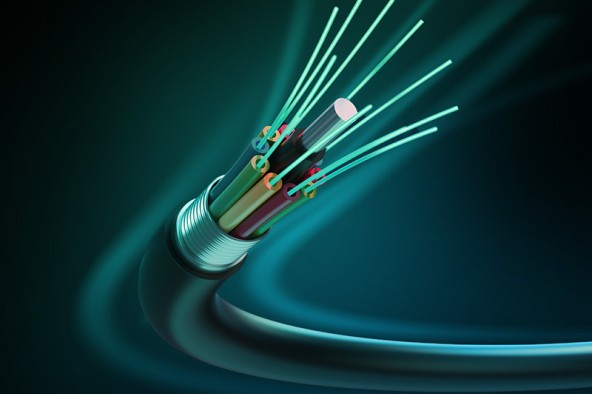Fiber optic cable is an advanced data transmission technology that uses light to transfer information at extraordinary speeds and over long distances. Its unique design allows it to minimize signal loss and protect against various forms of interference. Fiber-optic Internet breaks speed records, allowing to connect households as well as industrial, scientific and medical infrastructure of the highest quality.

The principle of optical cables is deceptively simple. Using light as a carrier of information, an optical fiber is built in a way that allows light waves to bounce off the walls of the cable. The refraction phenomenon allows for speed and stability parameters unattainable by standard cables - ultimately, light travels at the fastest speed in space, allowing it to surpass most of the limitations of older technologies.
Practical applications of fiber optics
Industry and science
Fiber optics are used in industry and science, where high bandwidth and minimal interference are required. They are used in telecommunications, long-distance data transfer, in measurement sensors for monitoring environmental or structural conditions. With fiber-optic connectivity, advanced research or production equipment can be constantly online.
Medicine
In medicine, fiber optics are enabling the development of modern imaging techniques, such as endoscopy, where flexible fiber optics transmit images from inside the body, offering doctors better insight into the areas being diagnosed and check the effectiveness of the therapy being used in real time.
Network infrastructure
In businesses and educational institutions, fiber optics are the backbone of modern networks, providing high-speed Internet access, data transmission and connectivity between buildings. They allow the construction of fast and reliable internal and external networks. This is a telecommunications breakthrough, allowing to send and download data over long distances at lightning speed.

High-speed fiber-optic Internet at home
Fiber optic network is by far the best home Internet, beating not only mobile or radio Internet, but also virtually any other solution based on classic copper LAN connections. Thanks to fiber optics, among other things, you can upload and download large files, watch movies and TV series in the highest quality and play games without delays, enjoying the fastest transfer and stable Internet regardless of external factors.
Fiber-optic cable is a technology that is widely available today in the telecommunications market for individual consumers. In the offer of t-mobile, Orange and other popular providers, you can find many ways to hook up superfast Internet to your home. Best of all, in consumer solutions, it doesn't require additional expensive equipment. If you're in range of a fiber optic cable, a standard router with compatible bandwidth will allow you to create a home ethernet and wi-fi network for the highest quality connection.
History of the origin of fiber optic technology
The origins of fiber optics date back to the 1950s, when scientists began to explore the possibility of transmitting light through flexible fibers. The first breakthrough came in 1966, when Charles Kao and George Hockham proposed that fiber optics could revolutionize telecommunications by sending data over long distances with minimal signal loss. In 1970, Corning Glass Works created the first fiber with low signal loss, paving the way for the commercial use of fiber optics.
Today, the technology is increasingly popular in the professional and consumer markets. By 2030, its market share is expected to double from 2020, exceeding by more than three times the share of classic LAN cables made of high-grade copper.
How is an optical fiber cable constructed?
The construction of a fiber optic cable with its core, jacket, covering and connectors is the foundation for modern telecommunications and broadband Internet access. Providing high bandwidth, reliability and resistance to electromagnetic interference, fiber optic cables are indispensable in many aspects of modern data transmission. Here is a detailed description of the various structural elements of a fiber optic cable:
Fiber optic core
The core is the central part of a fiber optic cable through which light passes. It is usually made of very pure silicon (silica) glass or, less commonly, plastic. The core has a very small diameter, in the case of single-mode optical fibers it can be as small as a few micrometers. It is in the core that the phenomenon of total internal reflection occurs, which allows the light to stay inside the cable and be transmitted efficiently over long distances.

Based on the types of fiber in the core, we distinguish between cables:
- single-mode (SM - single mode), characterized by a core diameter of 9 micrometers; optimal for long-distance data transmission, even up to 100 km;
- multimode (MM - multi mode), in which the thickness is 50 micrometers or more; typically used for transmission over shorter distances, up to 2 km.
Fiber optic sheath
Surrounding the core, the mantle has a slightly higher index of refraction than the core, but its main function is to keep the light in the core through total internal reflection. The mantle is made of a material that physically separates the core from the outer protective layers of the cable. Its presence is crucial to the efficiency of signal transmission, as it prevents light from leaking outward and allows data to be transmitted over long distances without significant losses.
Fiber optic coating
Coating, also known as protective coating, is the outer layer of a cable that protects it from mechanical damage, environmental influences such as moisture or temperature changes, and from harmful chemicals. The covering can be made of a variety of materials, including PVC (polyvinyl chloride) or LSZH (Low Smoke Zero Halogen), which is a material that emits little smoke and no halogens when burned. The covering also provides protection from potential external hazards and helps maintain the structural integrity of the entire cable.
Fiber optic connectors
Fiber optic connectors are key components that enable fiber optic cables to connect to various types of equipment, such as transmitters, receivers, splitters or other cables. There are many types of connectors, including SC (Standard Connector), LC (Little Connector), ST (Straight Tip) and MTP/MPO (Multi-fiber Termination Push-on/Pull-off), each designed to meet specific application requirements and installation environments. The connectors are essential for providing high-quality, stable fiber-optic connections that minimize signal loss and ensure the reliability of data transmission.
There are many criteria for the division of fiber optic connectors, which we will write more extensively about in the second part of this guide, scheduled for May/June 2024. The following is a summary of a few popular duplex fiber optic connector terminations, with the caveat that these are not all types of fiber optic connectors (nor are they all available from Lanberg).

Fiber optics vs. classic LAN cables
Compared to classic LAN (copper) cables, fiber optics offer much higher bandwidth and are less susceptible to interference. Copper LAN cables are more susceptible to attenuation and electromagnetic interference, which limits their effectiveness over longer distances.
Fiber optic network structure
A fiber-optic network consists of several key components, such as fiber-optic cables, connectors, splitters and terminal equipment, which are interconnected to provide fast and reliable data transfer. The network structure can be point-to-point, star, ring or a complex mixed network, depending on the requirements and topology.
In the next part of this guide, we will give you tips on how to discern in the maze of designations, what to follow when choosing cables, what devices to consider when building a network, and what are the most common mistakes to avoid in order not to expose yourself to losses of money and efficiency. Sign up for our newsletter and stay tuned for future installments of this compendium and other guides for professionals and laypeople alike.
Fiber optics have revolutionized the way data is transmitted, offering unprecedented speed and reliability. Their role in modern telecommunications, medicine, science and network infrastructure is invaluable, opening up new possibilities and setting the standard for future generations of data transfer technology.
Check out Lanberg solutions for your business or home
If you can take advantage of top technology, why not upgrade already? Explore our wide range of fiber optic patchcords, pigtails and adapters that will allow you to enjoy all the benefits of fiber optic cables, regardless of your industry. Go to the Lanberg store, where you will find superfast fiber optic cable of virtually any length and parameters, as well as a set of necessary accessories to build the rest of your network infrastructure.
Do you supply Lanberg products or would you like to start cooperation with us? Become our partner!







